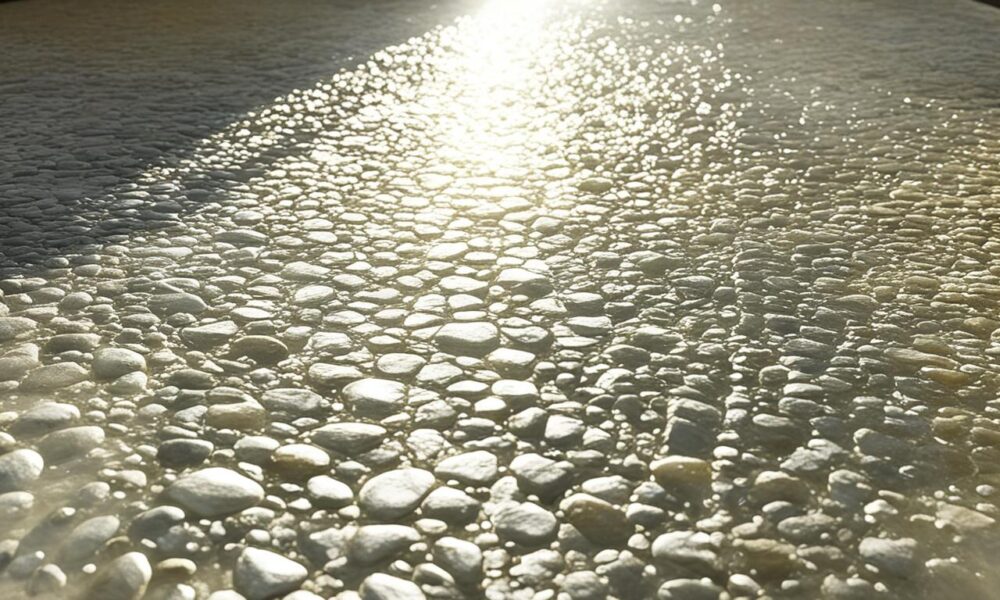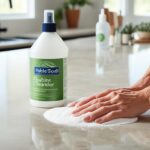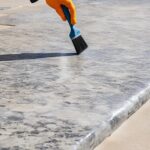The Ultimate Guide to Maintaining Natural Stone Surfaces
Natural stone surfaces like marble, granite, and quartzite can make any space look elegant and timeless. They need special care to keep looking great and strong. This guide will show you how to take care of your natural stone, so it stays a stunning feature for years.
It’s key to take good care of your stone to keep it looking beautiful and lasting long. Knowing how to clean, seal, and maintain each type of stone helps protect your investment. This guide will give you the tips and tools to keep your marble countertops, granite floors, or quartzite backsplashes looking their best.
Key Takeaways
- Natural stone surfaces require specific care based on their unique properties
- Regular cleaning with gentle, pH-neutral cleaners is crucial for maintaining stone surfaces
- Sealing is a vital step in protecting natural stone from stains and etching
- Prompt action is necessary when dealing with spills and stains
- Professional help may be needed for deep stains, etches, cracks, and chips
Understanding Your Natural Stone
Before you start cleaning your natural stone surfaces, it’s key to know what makes each type special. Natural stone falls into three main groups: Sedimentary, Metamorphic, and Igneous. Some stones, like those made of calcium carbonate, are Calcareous. Others, like those with lots of silicates, are Siliceous.
Properties of Marble, Granite, and Quartzite
Marble, granite, and quartzite are top choices for countertops. Each has its own unique traits. Marble is famous for its beauty and softness. Granite is tough and resists chips and scratches well. Quartzite combines durability with a stylish look.
| Stone Type | Hardness (Mohs Scale) | Porosity | Heat Resistance |
|---|---|---|---|
| Marble | 3-5 | Moderate to High | Moderate |
| Granite | 6-7 | Low | High |
| Quartzite | 7-8 | Low to Moderate | High |
Susceptibility to Stains and Etching
Each natural stone type reacts differently to stains and etching. Marble, being Calcareous, is very sensitive to acidic foods and cleaners. It can etch or stain easily. Granite and quartzite, being Siliceous, are more resistant to kitchen acids.
To prevent stains, sealing your stone is key. Sealers used in the stone industry help protect the stone from stains. How often you should seal depends on the stone type:
- Granite: every 1-2 years
- Marble: every 6-12 months
- Quartzite: annually, depending on the specific type of quartzite
Knowing your stone’s unique traits helps you keep it looking great for a long time.
Regular Cleaning Dos and Don’ts
Keeping your natural stone surfaces looking great requires regular cleaning with the right products and methods. Follow these simple tips to keep your marble, granite, or quartzite looking new for a long time.
Using Gentle, pH-Neutral Cleaners
For cleaning natural stone, it’s key to use gentle, pH-neutral cleaners. These products clean your stone well without causing damage. Here are some tips for using these cleaners:
- Always use a soft, non-abrasive cloth or sponge to apply the cleaner.
- Dilute the cleaner with warm water as the manufacturer suggests.
- Avoid using too much water, as it can seep into the stone and cause staining or damage.
- Rinse the surface well with clean water after cleaning to remove any residue.
- Dry the surface with a soft, clean cloth to prevent water spots or streaks.
Some recommended pH-neutral cleaners for natural stone surfaces include:
| Brand | Product | Suitable For |
|---|---|---|
| Dry Treat | Countertop Cleaner Spray | Marble, Granite, Quartzite, Limestone, Travertine |
| Fila | Countertop Sealer & Cleaner | Marble, Granite, Quartzite, Limestone, Travertine |
| More | Premium Stone Sealer | Marble, Granite, Quartzite, Limestone, Travertine |
Avoiding Acidic or Alkaline Cleaners
Remember, when cleaning natural stone, avoid acidic or alkaline cleaners. These can etch or dull your stone, causing permanent damage. Some cleaners to skip include:
- Vinegar
- Lemon juice
- Bleach
- Ammonia
- Abrasive cleaners
According to the guide on maintaining natural stone surfaces, don’t use vinegar, lemon juice, or other acid cleaners on marble, limestone, travertine, or onyx surfaces.
Instead, choose gentle stone cleaners made for natural stone. These products will clean your stone without causing damage or etching.
By following these simple cleaning tips, you can keep your natural stone surfaces looking beautiful and new for years.
Sealing: A Crucial Step for Protection
Sealing your natural stone is key to keeping it beautiful and durable. Stones like marble, granite, and quartzite are strong but can stain or get damaged without protection. A study by the National Center for Preservation Technology and Training shows that preparing the stone well can make sealers work up to 40% better.
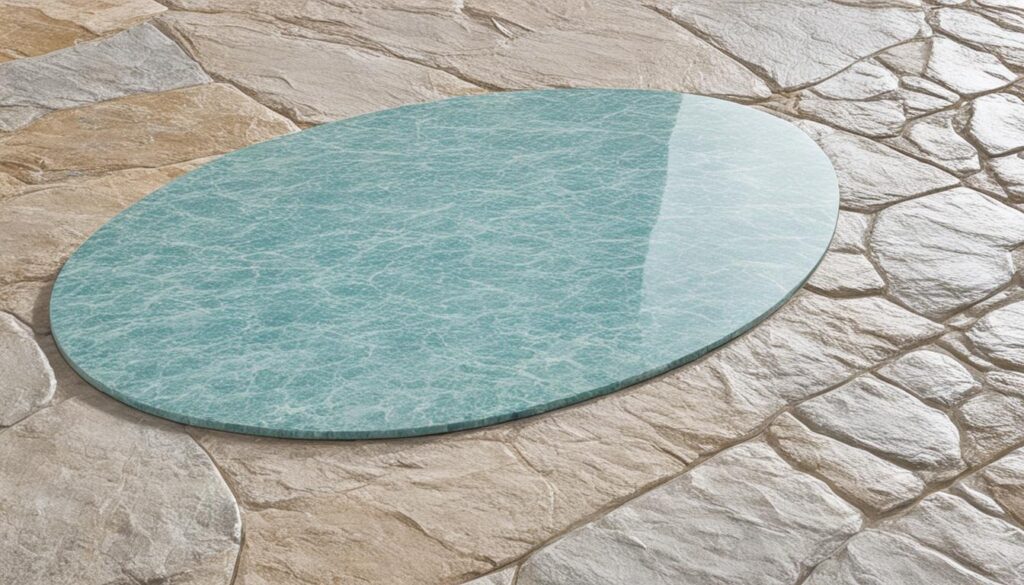
There are two main types of stone sealers: penetrating and surface sealers. Penetrating sealers work best for most stones, filling pores to protect from within. Surface sealers add a protective layer on top, making the stone look better. But, they need to be reapplied more often.
“Sealing your natural stone surfaces is the best way to protect your investment and keep them looking beautiful for years to come.” – Emily Johnson, Stone Care Expert
The sealing process takes 10-20 minutes for the sealer to soak in. Some sealers need extra time to dry before adding more coats. Always follow the product’s instructions for the best results.
| Stone Type | Sealing Frequency |
|---|---|
| Marble | Every 6-12 months |
| Granite | Once a year |
| Quartzite | As recommended by supplier |
Granite and quartzite don’t need sealing as often because they’re denser. Marble, being more porous, needs sealing more often. The Stone and Tile School found that most stones are between 0.2% and 5% porous. This means cleaning well before sealing is crucial.
You should reseal your stone every 1-2 years in high-traffic areas. Less used areas might only need resealing every 3-5 years. Always clean spills right away to prevent stains. Check your sealer regularly for damage or wear.
A study from the University of Florida in 2021 showed that unsealed stone can degrade up to 30% faster than sealed stone. Regular sealing protects your stone from stains, etching, and wear. This keeps your stone looking great for years.
Dealing with Spills and Stains
Natural stone surfaces are tough but can still get stained from spills and accidents. To keep your stone looking great, act fast when a spill happens. This stops liquids from going deep into the stone and causing hard stains.
Immediate Action to Prevent Stains
When you see a spill on your stone, gently blot it with a clean, dry cloth. Don’t wipe it, as that can spread the stain. Blotting absorbs the liquid without pushing it deeper into the stone. Then, rinse the area with clean water and dry it well with a soft cloth.
“Time is of the essence when it comes to preventing natural stone stains. The quicker you act, the less likely the spill will leave a permanent mark on your beautiful stone surface.”
Removing Oil-Based and Water-Based Stains
Oil-based stains like grease and cosmetics are tough to remove. Make a paste with baking soda and water for these stains. Put the paste on the stain, cover it with plastic wrap, and wait 24 to 48 hours. The paste will pull the oil out of the stone, removing the stain.
For water-based stains like coffee and wine, mix hydrogen peroxide with a bit of ammonia. Put this mix on the stain, cover it with plastic wrap, and let it sit. The mixture will break down the stain, making it easier to clean.
| Stain Type | Cleaning Solution | Application Method |
|---|---|---|
| Oil-based (grease, cooking oil, cosmetics) | Baking soda and water paste | Apply paste, cover with plastic wrap, let sit for 24-48 hours |
| Water-based (coffee, tea, wine) | Hydrogen peroxide and ammonia mixture | Apply mixture, cover with plastic wrap, let sit for several hours or overnight |
The success of a stone poultice depends on the stain type and how long it has set in. Always clean spills right away and use the right method for your stone type.
- Blot spills immediately with a clean, dry cloth
- Rinse the area with clean water and dry thoroughly
- Use a baking soda and water paste for oil-based stains
- Apply a hydrogen peroxide and ammonia mixture for water-based stains
- Allow the poultice to work for several hours or overnight
By acting fast and using these tips, you can remove stains from natural stone and keep your surfaces looking great.
Preventing Etches and Scratches
Sealed natural stone surfaces are more resistant to stains and moisture. But, they can still get etched or scratched. Etching happens when acidic things touch the stone, making dull spots or changing the color. Scratches come from moving heavy or sharp things over the stone. To keep your natural stone looking great, it’s key to prevent etching and scratching.
Using Coasters and Trivets
Using coasters under acidic drinks like citrus or alcohol can prevent etching on your stone. Also, putting hot dishes directly on stone can cause damage. So, always use trivets or hot pads under hot items. This keeps your stone looking beautiful and stops etches.
Avoiding Dragging Objects on Stone Surfaces
Scratches happen when you drag heavy or sharp things over the stone. Always lift and place items carefully to avoid this. This is crucial for things like pottery, glassware, and appliances that can scratch softer stones. Also, don’t put heavy or sharp things directly on the stone to prevent chips or deep scratches.
| Stone Type | Etching Susceptibility | Scratching Susceptibility |
|---|---|---|
| Granite | Low | Low |
| Marble | High | Moderate |
| Quartzite | Moderate | Low |
| Limestone | High | High |
| Travertine | High | Moderate |
By following these simple steps, you can greatly lower the chance of etching and scratching your natural stone. Regular care and quick action on spills and stains will keep your stone looking great for a long time.
Regular Maintenance and Care
Keeping your natural stone surfaces clean is key, but it’s not the only thing you should do. Regular check-ups by professionals are important, especially for busy areas like floors. These check-ups can spot and fix problems early, saving you time and money.
Even with good care, your natural stone may lose some shine over time. This is especially true for marble and shiny finishes. To get your stone’s shine back, think about getting professional stone polishing every few years. Experts use special tools and methods to make your stone look new again.
Natural stone is beautiful and strong, but it needs regular care to stay looking great. With the right care, your natural stone can last a long time.
For deep cleaning, it’s best to call in professional stone cleaners. They know how to clean your stone safely and well, using the right products. They can get rid of tough stains and dirt without harming your stone.
Regular care for your stone, including stone restoration and professional cleaning, makes your stone last longer. By taking good care of your stone, you can enjoy its beauty and elegance for many years.
DIY Tips for Natural Stone Care
If you like to do things yourself, there are safe ways to care for your natural stone surfaces. With simple ingredients and some effort, you can keep your stone looking great for years. Here are some easy DIY tips for stone care that help with everyday cleaning and tough stains.
Homemade Cleaner Recipe
Using a homemade cleaner is a simple way to keep your stone clean. Just mix a few drops of mild dish soap with warm water in a spray bottle. This mix is great for removing dirt, dust, and light stains without harming the stone. Always use a soft cloth or sponge to clean, as hard materials can scratch the stone.
When making your stone cleaner, avoid acidic ingredients like lemon juice or vinegar. These can damage stones like marble and limestone. Use only pH-neutral soaps and cleaners to keep your stone looking perfect.
Creating Poultices for Stains
For hard stains, a DIY stone poultice can work well. A poultice is a paste you apply to the stain and let sit for a few hours or overnight. It pulls the stain out of the stone, making it easy to remove.
To make a poultice for oil-based stains, mix baking soda with water until it’s a thick paste. Put the paste on the stain, cover it with plastic wrap, and let it sit for 24-48 hours. For organic stains like coffee or tea, mix hydrogen peroxide with a few drops of ammonia and apply it the same way.
| Stain Type | Poultice Ingredients | Application Time |
|---|---|---|
| Oil-based (grease, makeup, etc.) | Baking soda + water | 24-48 hours |
| Organic (coffee, tea, food, etc.) | Hydrogen peroxide + ammonia | 24-48 hours |
By using these DIY tips, you can keep your stone surfaces looking great without harsh chemicals or expensive services. Always test your cleaners and poultices on a small area first to make sure they won’t harm your stone. If you have deep stains or etching, don’t hesitate to get professional help for the best results.
When to Call Professionals
While you can take care of some natural stone tasks yourself, some jobs need expert help. Homeowners with granite, marble, limestone, or travertine should know when to get professional help. This keeps their stone looking great and lasting longer.
Dealing with Deep Stains and Etches
Deep stains and etches that go past the surface need a pro. They require special knowledge and tools to get rid of them without harming the stone. Experts in stone restoration can figure out how bad the stain or etch is and what to do next.
Here are some deep stains and etches that might need a pro:
- Oil-based stains from cooking grease or makeup
- Organic stains from food or drink spills
- Ink or dye stains from markers or pens
- Etches from acidic things like wine, citrus, or cleaners
Repairing Cracks and Chips
Cracks and chips in natural stone look bad and can get worse if ignored. Getting a pro for stone crack and chip repair is key to fixing the stone right. Experts can fill and match the damaged spots, making it look new again.
Think about these things when getting professional help for cracks and chips:
- The stone type and damage size decide the repair method
- Fixing it fast stops cracks from getting bigger and more damage
- Professionals can match the color to keep it looking right
| Stone Issue | DIY Care | Professional Care |
|---|---|---|
| Light surface stains | Use gentle cleaners | Not usually needed |
| Deep, stubborn stains | Try to remove with special cleaners or poultices | Get a pro for the best stain removal |
| Minor etches | Buff with a soft cloth and marble powder | Get a pro for deep or big etches |
| Cracks and chips | Don’t try it yourself to avoid more damage | Get a pro for a lasting fix |
Knowing when to call pros for stone etching, stain, and repair keeps your stone looking great and lasting long.
Choosing the Right Stone for Your Space
Choosing natural stone for your home is crucial. You need to think about each stone’s unique qualities and upkeep. Granite is a top pick for countertops because it’s tough and doesn’t stain or scratch easily. In 2024, natural, earthy tones are in for granite countertops, blending old and new styles.
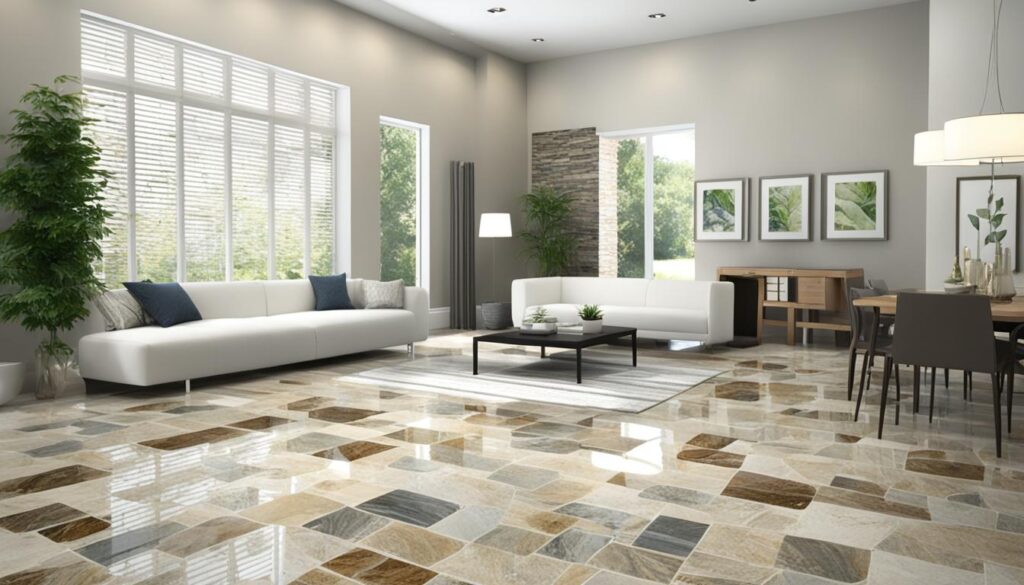
Quartz countertops are getting popular for their bold looks and eco-friendly making. Calacatta quartz is leading the trend with its style and strength, mixing natural stone beauty with quartz’s durability and easy care.
Quartzite is great for bathrooms because it’s strong, easy to look after, and won’t let moisture in. Porcelain is also on the rise for vanity tops, offering strength and design flexibility for any style from modern to classic.
“Choosing the right natural stone for your space is a crucial decision that can greatly impact the overall aesthetic and functionality of your home. It’s important to consider not only the visual appeal but also the practical aspects of each stone type to ensure it meets your specific needs and requirements.”
Use a stone usage guide to pick the best stone for your project, like flooring, countertops, or walls. Remember, mixing stones with different properties can cause wear and upkeep issues, especially outside.
| Stone Type | Ideal Applications | Key Properties |
|---|---|---|
| Granite | Countertops, flooring, exterior cladding | Durable, resistant to stains and scratches |
| Marble | Countertops, flooring, wall coverings | Elegant, heat-resistant, prone to etching |
| Quartzite | Countertops, flooring, bathroom surfaces | Tough, low-maintenance, moisture-resistant |
| Limestone | Flooring, wall cladding, exterior applications | Soft, porous, requires sealing |
| Travertine | Flooring, wall coverings, exterior surfaces | Porous, textured, requires sealing |
Some white or lightly colored marbles and onyxes can be translucent, adding an interesting look but consider it when choosing stones. By looking at your needs and each stone’s features, you can pick the best stone for your space, making it beautiful and functional for years.
Conclusion
Keeping natural stone surfaces looking great and lasting long takes special care. This guide has given homeowners tips for marble, granite, and quartzite. By following these tips, you can keep your stone surfaces looking new for many years.
Start with regular cleaning like dry sweeping, vacuuming, and damp mopping with cleaners that don’t harm the stone. Sealing your stone is key to protect it from stains and moisture. Also, using coasters and placemats helps avoid scratches and etches. If you have deep stains, etches, or cracks, get help from a stone restoration expert for the best fix.
Natural stone needs more care than synthetic materials but is worth it for its beauty and character. By taking good care of your stone and knowing what each type needs, you can keep your marble, granite, or quartzite looking great. This way, your stone will stay a beautiful part of your home for years to come.

